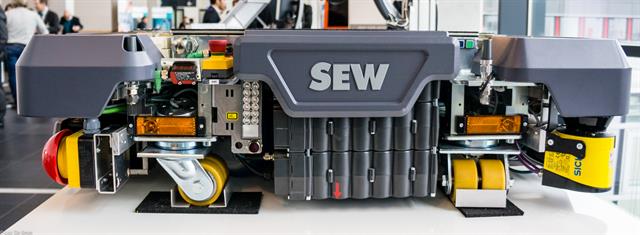 SEW-Eurodrive's Gerda |
By Luc De Smet Automated Guided Vehicles (AGVs) have been around for decades, but their application has been limited by the need to hardwire the hardware, reducing their flexibility.
The notion of 'cobots' (collaborative robots) is helping to drive home a new, more flexible message.
During the press preview of the upcoming Hannover Messe, SEW-Eurodrive showed a prototype of its newest AGV platform labeled a 'mobile assistant system'. "We brought key components together that we were marketing anyway to develop an answer to challenges we experienced in our own internal logistics," says spokesman Gert Bockelmann.
About a dozen of these AGVs are operational in SEW-Eurodrive's Smart Factory 2020 demo facility in Graben-Neudorf.
The model on show, Gerda, weighs 350 kg but carries about 1.5 T. Two central wheels are motorised and used for steering. Rollers at the four corners keep the platform balanced. At the top, on opposite sides, a baseboard lifts loads some 250 mm high. Gerda runs on super-capacitors that can be induction-charged. Opportunity charges of 30 seconds provide enough energy for six to eight minutes of operation - 75% faster than required for lithium-ion batteries.
Currently, the units communicate with one another via WiFi. The system also uses 'swarm technology'. Various units could cluster and work together to transport larger and heavier loads, "but, currently, that is but an idea we are developing the main components for. Technically, that should not be all that complicated but it does require an actual application," according to the company.
The company's Mobile Assistant System will be tested at several client facilities, including Audi in Neckarsulm. Bockelmann expects the AGV to hit the market within the next two years. The main challenges for the developers are to reduce the size of the technology and push down costs. "Up to now, a similar machine would cost some EUR60,000 (USD66,000). We want to bring the price down to EUR20,000 (USD22,000) a piece."
These developments fit into SEW-Eurodrive's Lean Industry 4.0 strategy. The company assembles its Mobile Assistant System, Movivision application software, drives and Movi-C Controller as building blocks in a variety of combinations.
It also designed a Mobile Assembly Assistant, an autonomous mobile workbench that moves from one assembly cell to the next. Another configuration is the SEW-Handling Assistant, an autonomous mobile platform with robot arm and camera vision for pick and place operations. The company is also working on a 'mobile logistics capsule'. This AGV is like a self-driving cupboard that transports a variety of components or goods within a factory. SEW-Eurodrive talks about a capsule that knows what it is transporting and what for. In time, these capsules could also be transported between factories and suppliers. They would hop onto a trailer or train, hop off at their destination and continue their way to the right location or work spot - and may later even reach out towards customers. The company estimates that these could operate at speeds of up to 30 km/h, have braking distances of 2 m or less, 90 degree turns and slopes of 12%, while transporting up to 3 T.
 Fabian Breës |
Toyota Material Handling Europe, meanwhile, has awarded two of its top three prizes at the recent Toyota Logistic Design Awards to collaborative AGV designs.
First prize went to a young Belgian, Fabian Breës, for his 'Flock' concept in which various autonomous logistics vehicles collaborate in the warehouse. The larger 'Mother Goose' is a riding mast with forks, a 'portal' that lifts loads 5 m high while stabilisers are being extended left and right at the bottom. One 'Goose' services several smaller 'Ducklings' within the 'Flock'. The designer estimates that the combination of one Mother Goose and two Ducklings would perform as well as three forklifts with drivers but at much lower cost.
The third prize in the contest went to the Finnish team of Vajani Räisänen, Antti Laukkanen and Sami Laiho and their Toyota KAMU concept that also builds on the notion of collaborative AGVs. Here, the main truck lifts the smaller AGV-transpallet into a container where it will pick up pallets and bring them back to the truck to be lowered together and continue move on through the warehouse.